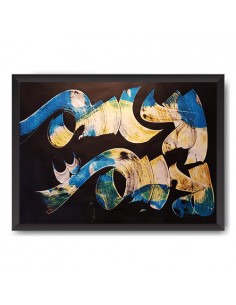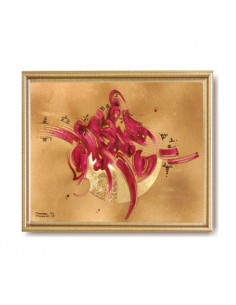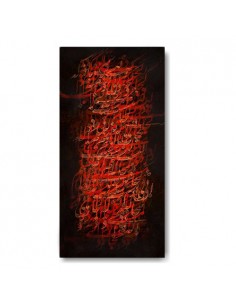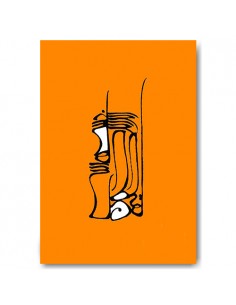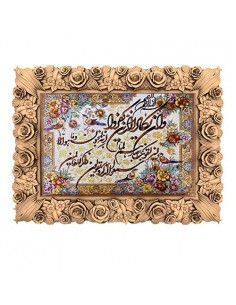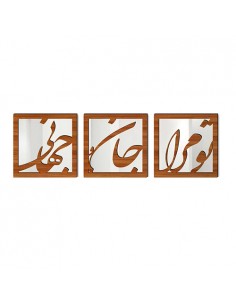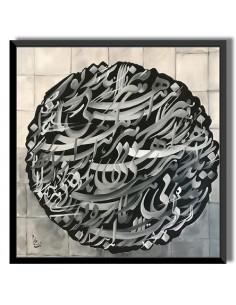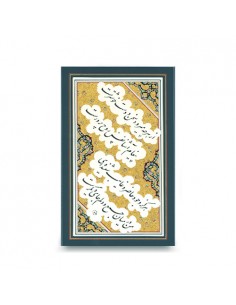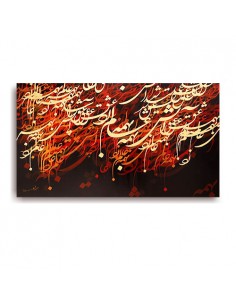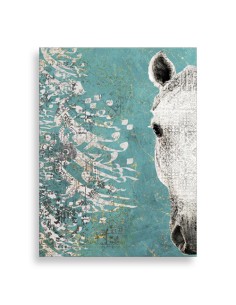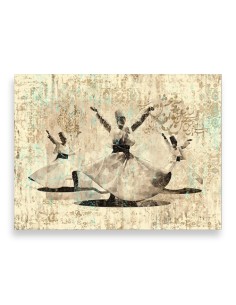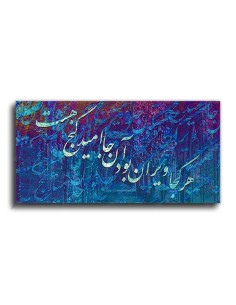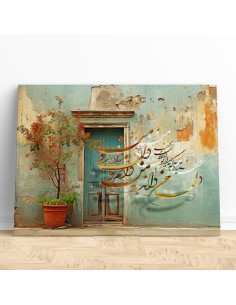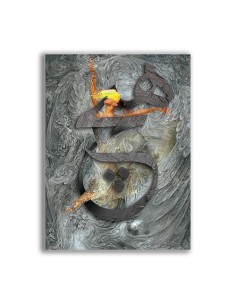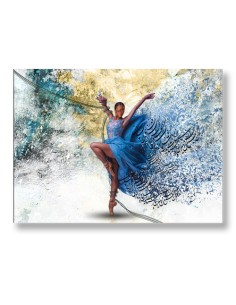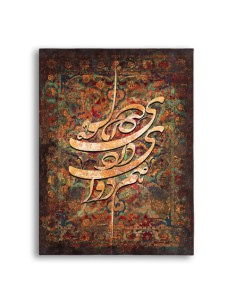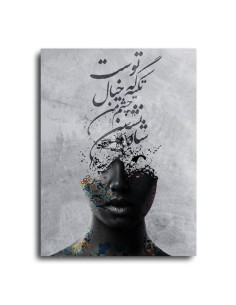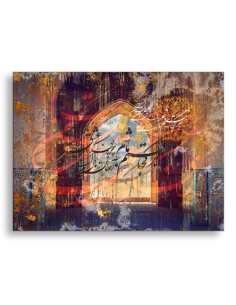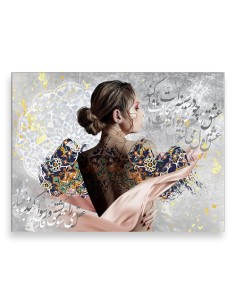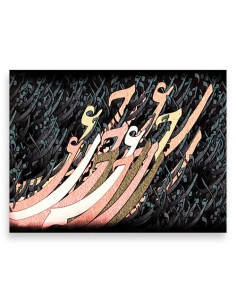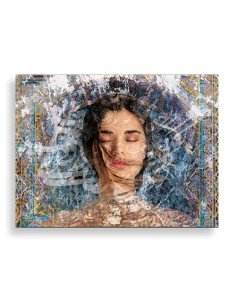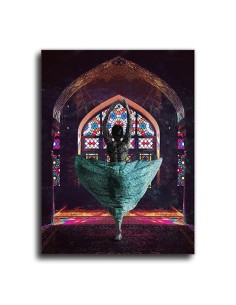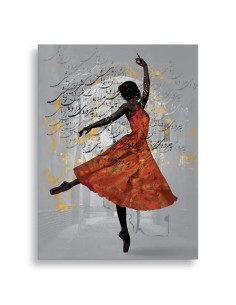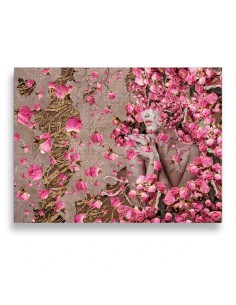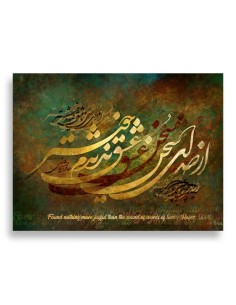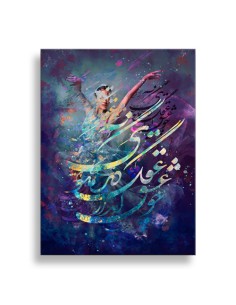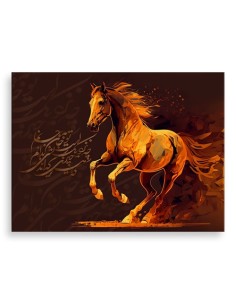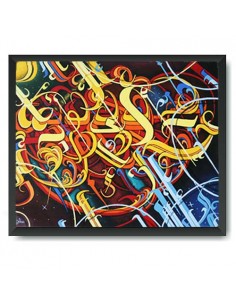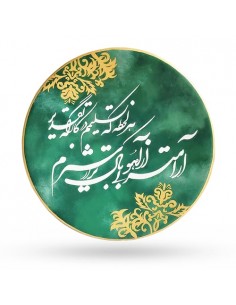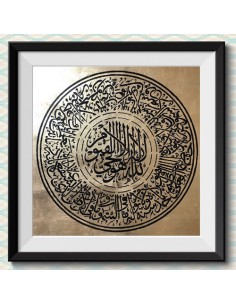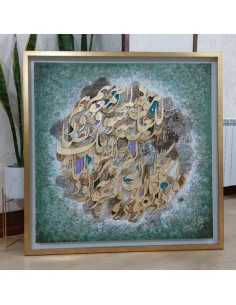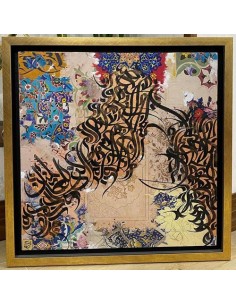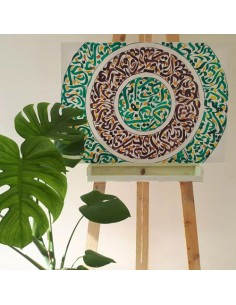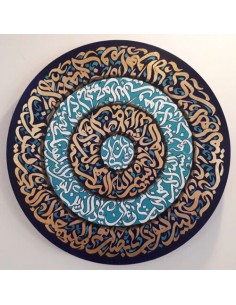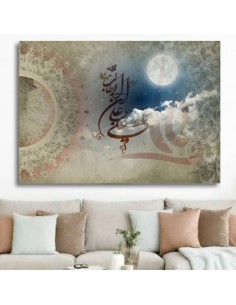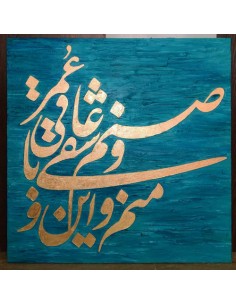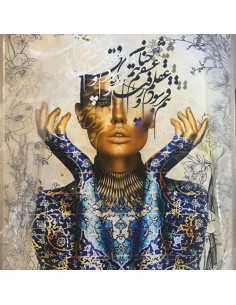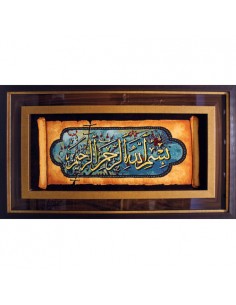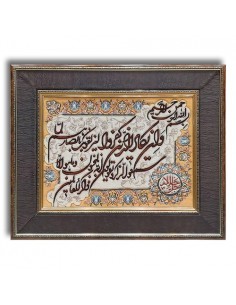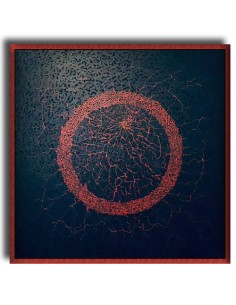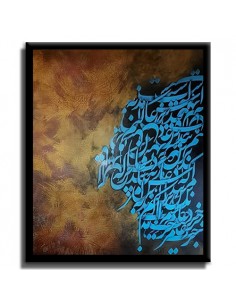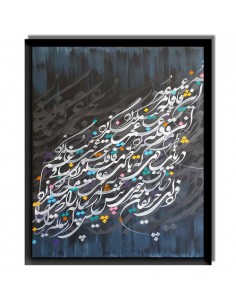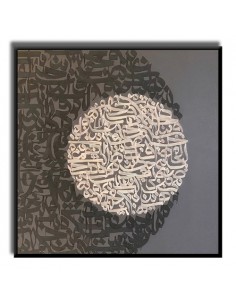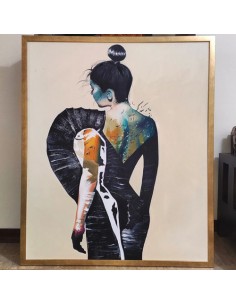Calligraphy Wall Decorative Tablou
Ancient Persia's advanced culture and economy, as well as its dedication to scientific, artistic, and cultural development, called for a tool to preserve and pass knowledge on to future generations. This need was started by the advent of cuneiform circa 4,000 BC and has now reached the Nasta'liq script and wall art forms like calligraphy painting.
Persian Calligraphy: Review, Select, and Buying Tips
If you want to review Persian calligraphy to select the best one before you buy, you are in the right place. The Persian artful writing method as we know it today, Persian Calligraphy, originated about 1,000 years ago. A combination of the Semitic, Arabic (Quran-based calligraphies such as Ayat-al-Kursi calligraphy), Kufic, and other scripts, the writing system offered a vast field for artistic creation. Thanks to its visual excellence and originality, the Persian script, calligraphy, is considered a form of fine art, and nowadays, there is a painting form of it which is called calligraphy painting.
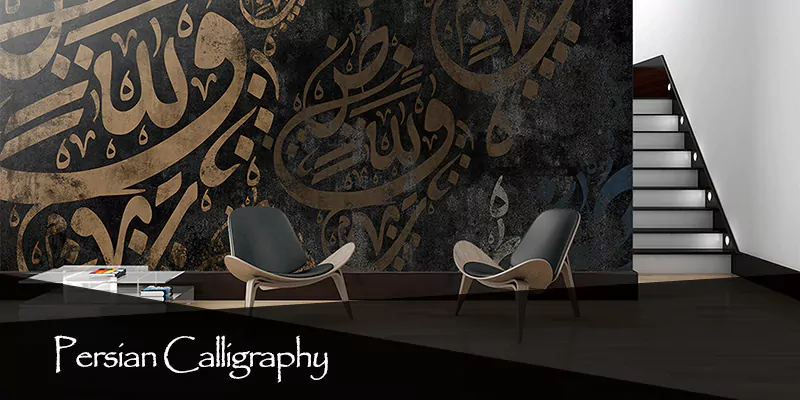
Cyrus Crafts; Luxury & Unique Products
Select and Buy Calligraphy Wall Art
People and interior designers today select and buy calligraphy artwork, one of the oldest and most flawlessly beautiful forms of wall art, for home designs to reflect the excellent taste of the homeowner in art. But how do you select the most proper ones to buy?
Using canvas calligraphy in Interior Design, besides other framed wall art like painting canvas, wall rugs, and miniature and abstract painting, is perhaps the simplest and one of the best ways to bring the precious art of Persian calligraphy into your home or place of work. The text in works of framed/canvas calligraphy is often well-known verses of Persian poetry, an Islamic prayer, Quranic verses, a quote, or a proverb.
So, select the calligraphy artwork that reflects your personality and shop from reliable sellers.
Persian Calligraphy Scripts
Persian calligraphy is one of the oldest and most significant forms of art; it originated in Iran and remains popular in the Islamic world. This kind of writing is rather complex and plays not only the role of a communication tool; it is also a tool to convey artistic and spiritual values. Persian calligraphy as an art form has a long history due to the Persian culture, and this has led to the development of different scripts depending on the style and utilization:
Muhaqqaq/Mohaqiq Calligraphy Script
Muhaqqaq or Mohaqiq is a calligraphic script of high rank that emerged in the tenth Century. It is more than evident in this font, especially due to the thick strokes it has, giving it a king-like aura. This script was mainly employed for taking down important textual contents such as the Quran and was well-liked by scholars and calligraphers.

The Muhaqqaq script is narrowly written and easily readable; therefore this script was highly used in carving on monumental rocks and buildings. Due to its firm appearance, it provides a disciplined and magnificent feel towards written content.
Reyhan/Reyhani Calligraphy Script
Reyhani script which is often referred to as the Reyhan script is elegant and fluid. Originated around the 15th century. This script was mainly adopted when writing poetry, literary texts, and also for ornate writings.

The style of the Reyhan script is highly aesthetic and highly representative of the Persian world of literature and poetry. This complexity gives the written language a civilizing quality that makes it a powerful tool.
Thuluth/Sols Calligraphy Script
Sols or Thuluth is a semi-thick that evolved in the 7th century. This style is identified by the fact that its letters are long and beautiful, designed for the use of buildings and decorations. This script was employed commonly for taking down literary works, poems, and calligraphic compositions.

Thuluth’s is characterized as the most beautiful of all forms of writing which emphasizes the beauty and flowing look of Persian literature. It becomes wild and appears to be dancing on the page due to its characteristics of being written in bold and cursive.
Naskh Calligraphy Script
Naskh script is a cursive one, an offshoot of which began in the 10th century. It is characterized by its cursive and running styles for the letters that are usually employed in recording books, manuscripts, and official writings. This script was used for most of the literary and administrative messengers.

There is no doubt that the Naskh script is one of the most legible scripts and is thus considered suitable for transcribing texts and documents. Because it is written in cursive, it has a kind of free-flowing and aesthetically pleasing appeal to the writing.
Tawqi/Toqi Calligraphy Script
Tawqi or Toqi is one of the calligraphic scripts that were developed in the 16th century. It is a style of writing that has comparatively small letters that are employed in signatures, seals, and formal writings and documents. This script was dominant in the text writing administrative and bureaucratic practices.

The Tawqi script was established due to functionality and effectiveness and thus can be used in official writings and signatures.
Reqa Calligraphy Script
The Reqa is a cursive writing system employing script that dates back to the 15th century. This depicts free-flowing and thin strokes used letters that are mostly applied in matters related to personal letters, poetry, as well as literary books. This script was commonly used for private communications.

The script of Reqa is characterized by a certain distinctiveness of the graphic line, ease, and naturalness of handwriting, which reflects the beauty and restraint of the calligraphic artistry manifested in the expression of individuality and close interpersonal communication.
Persian Calligraphy Styles
Persian calligraphy art is well-known internationally for its details and includes different styles. Today, Persian calligraphy is also used as a decorative item in the interior design of homes and offices in different forms, such as the so-called "framed calligraphy art or calligraphy painting."
Here are the most popular and frequent styles of Persian calligraphy art:
Tughra Calligraphy Art
The tughra style of calligraphy was historically used to write the names and honorary titles of sultans in the form of a signature or seal. Stylistically, a tughra is an elaborate composition of curves, straight lines, and loops.
Musalsal Calligraphy Painting
All successive letters and words in this style join together, creating a beautiful, uninterrupted calligraphic sequence.
Reflected Calligraphy
This style is characterized by symmetry; that is, letters are mirrored about an axis.
Calligram Calligraphy
A calligram consists of letters and words arranged creatively to form an image, such as a human face or an animal.
Calligraphy of the Qur'an
Naskhi was the style used in the earliest Qur'ans written on paper or canvas. The style of calligraphy was developed in the 10th century by the Abbasid calligrapher Ibn Muqlah (886-940), and it was continued by Ibn al-Bawwab (1022). It refers to the verses of the book Qur'an and some of the most famous verses are "Ayat-al-kursi calligraphy," "Salavat Calligraphy," and "Wa In Yakad Calligraphy."
Persian calligraphy art comes in various color schemes, calligraphic styles, page border decorations, and frames, allowing you to find works that best fit your interior design, be it classic or modern.
Eventually, a relatively recent and originally Persian style, the calligraphic painting combines two art forms in a creative, modern fashion. The style has become highly popular in Iran and other countries and is frequently used as a décor element.
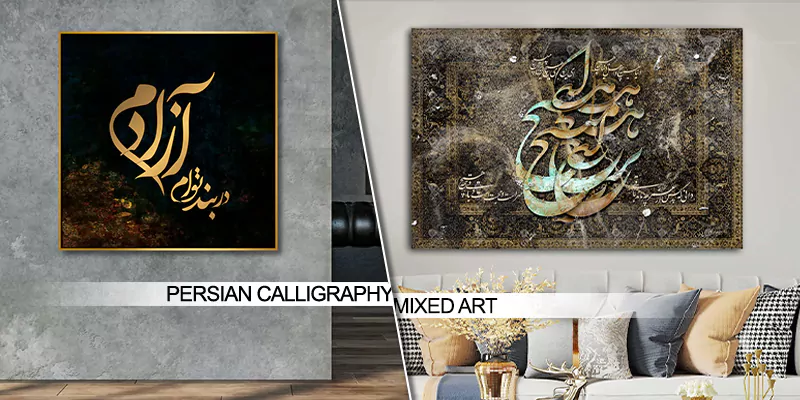
Calligraphy Art for Home Decor
Traditionally, the only way that calligraphy could decorate your home was in its framed/canvas form. Today, however, innovations in interior design and the modernization of traditional Persian arts have enabled décor calligraphy to go beyond the framed/canvas limit. There is now a great variety of items that incorporate Persian calligraphy into their design.
Cushions, tables, and chairs are among the most popular furnishings today. When adorned with letters and words in calligraphy, they can liven up a room.
The use of calligraphy has become pretty widespread in the fashion industry as well. Hugely popular, clothing decorated with Persian calligraphy beautifully showcases authentic Persian art and culture.
Persian Calligraphy Artists
After the Islamization of Persia, the Naskh style of Persian calligraphy rose to popularity, and about 600 years ago, Mir Ali Tabrizi incorporated it with the talaq style into Nasta'liq. Famous as the "bride of Persian scripts," Nastaliq is one of the most beautiful and artistic scripts in the world.
Among the prominent Persian calligraphers is Mir Emad Hassani, who is regarded as Iran's greatest calligraphy master. He lived about 450 years ago, during the reign of Safavid king Abbas the Great. Mir Emad's calligraphies are found in great numbers in buildings from the period. By making some changes to Nastaliq and introducing new stylistic rules in Persian calligraphy, Mir Emad enhanced the elegance of the script.
Mohammad-Reza Kalhor was another great Persian Nastaliq calligrapher who lived about 200 years ago, during the Qajar era. Similar to Mir Emad, Kalhor added to the rules of Nastaliq calligraphy. His work was so influential that modern Nastaliq can be said to be partly the result of his artistic taste and attitude.
Among contemporary Persian calligraphers, Gholam-Hossein Amirkhani stands out as one of the most accomplished..
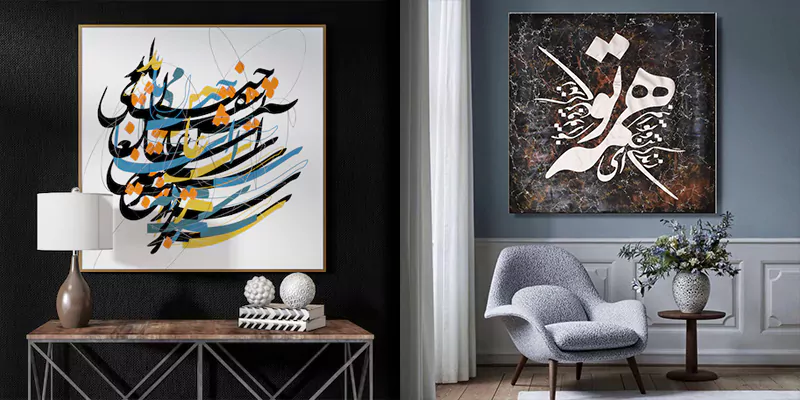
CyrusCrafts Wall Art Store: Canada and the USA
Step into a new dimension of culture and art at CyrusCrafts Wall Art Store. Our artwork store has a rich collection of Persian designs and you will find out that our collection of framed artwork that belongs to the wall art category will add beauty to your home or commercial space. From Persian calligraphy and canvases to decorative wall rugs, all are a narrative of tradition and elegance at CyrusCrafts wall art store.
Appreciate the elegance of Persian art in Canada and the USA. New and elegant handcrafted wall art pieces are available that will make your walls stand out and tell stories. CyrusCrafts is therefore an ideal place to find amazing wall decoratives to update the look of your home or find that perfect gift for a friend or a family member.
Cyruscrafts specializes in the supply, sale, and export of the finest calligraphy wall rugs and wall-hanging carpets. We bring you one-of-a-kind products that will liven up and individualize your home or workplace.


